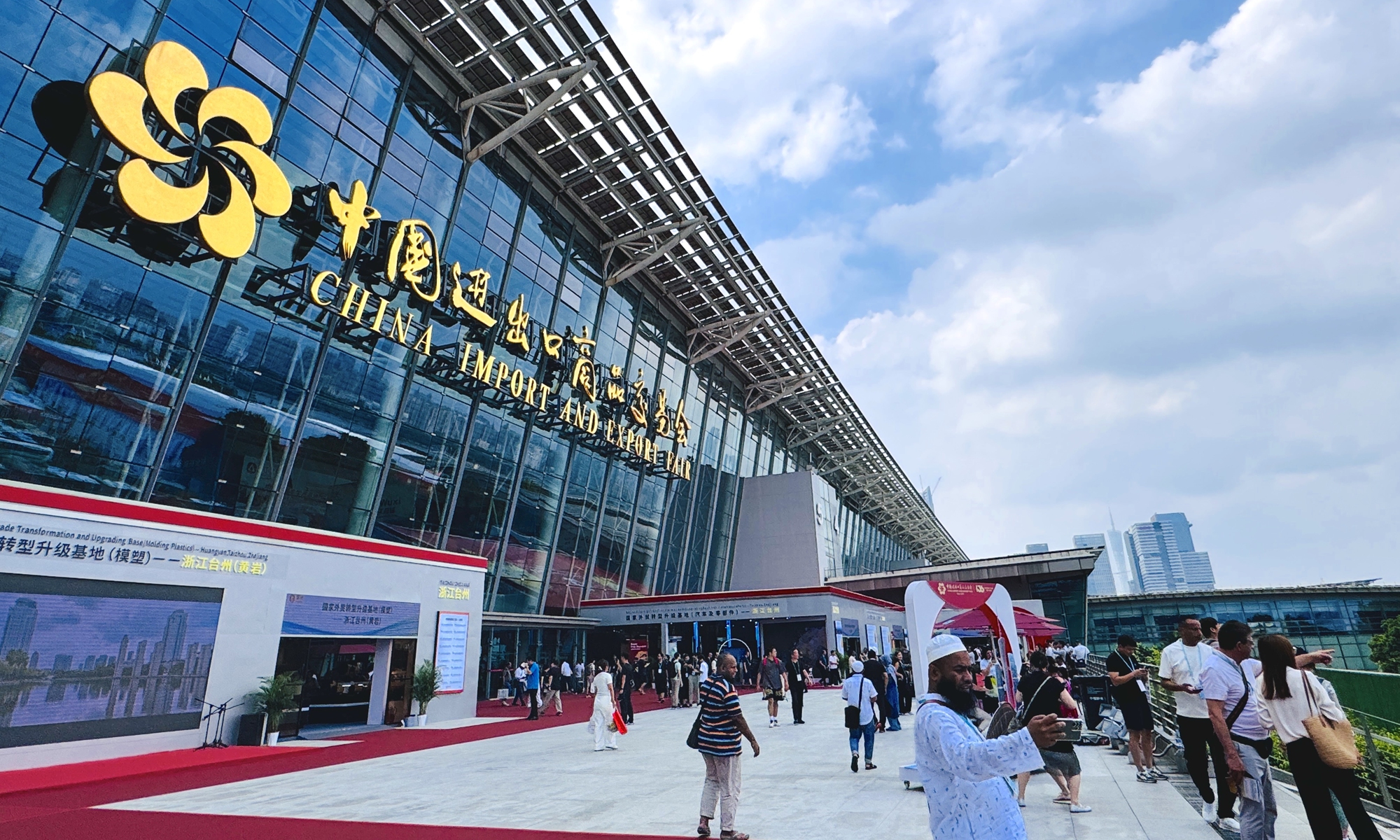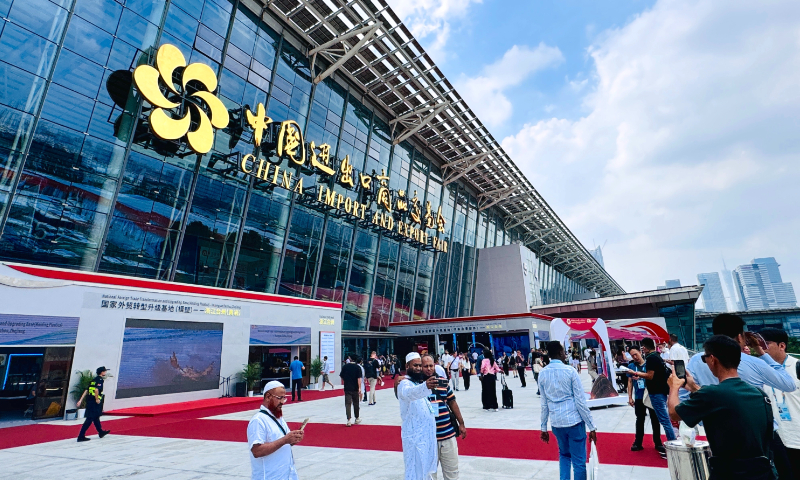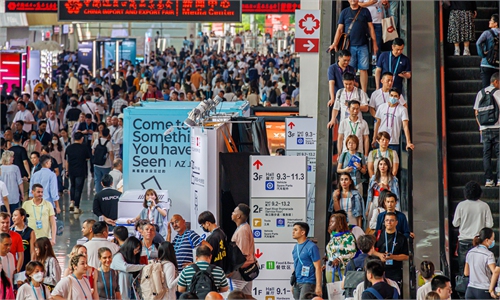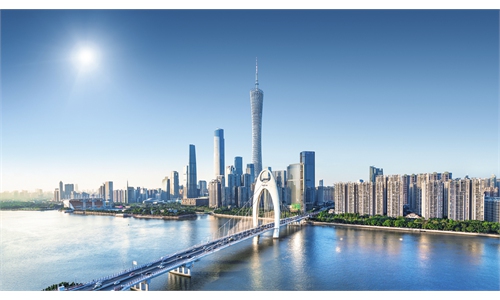Canton Fair displays Chinese high-tech products, attracting crowds of global buyers

Participants are seen at the Canton Fair complex on October 16, 2024, in Guangzhou, South China's Guangdong Province. Photo: Chi Jingyi/GT
Whenever you spot a big crowd of global buyers gathering at a booth in the Canton Fair complex, it's clear that high-tech, high-value-added products, such as industrial automation equipment, humanoid robots, intelligent bionic hands and hydrogen bicycles, are showcased by Chinese exhibitors.
This is a common scene at the 136th session of the China Import and Export Fair, commonly known as the Canton Fair, indicating that Chinese manufacturing is shifting to the middle and high-end of the industrial value chain, while Chinese enterprises' independent innovation capability and the core competitiveness of their products continue to grow.
Chinese exporters, especially private enterprises, have shifted from low-end manufacturing, or acting as original equipment manufacturer (OEM) - a factory that acts as a contractor to produce goods for companies that will sell them under their own brand - to technologically leading enterprises in many sectors with their own intellectual properties and innovation ability. Many have established their own brands, and have gained rising international recognition.
Driven by innovation
Chinese companies have increasingly focused on innovation and brand development in recent years, thereby enhancing their core competitiveness in the global market, the Global Times learned from Chinese exhibitors at the Canton Fair.
"In our 20 years of export and manufacturing experience, we primarily operated as an OEM for major brands in Europe and North America in the first 10 years. We launched our own brand in 2016," Sun Yuping, overseas sales director at Ansjer Electronics Co, told the Global Times at the Canton Fair, where it debuted an artificial intelligence (AI)-powered smart camera during the phase one (October 15-19) of the 136th Canton Fair.
China is the currently the center of global manufacturing, laying a strong foundation for mastering new technologies, said Sun.
Ansjer Electronics now has a research and development (R&D) team of 100 people, focusing on hardware, software, and design. In addition, it also has a team of 30 product managers who analyze user feedback globally, said Sun.
"We will introduce some new technologies at the spring session of the Canton Fair (usually in April and May), about six months after the current session. Enterprises need to keep innovating to remain industry leaders and stay competitive in the global competition," Sun noted.
Shanxi Jia Shi Da Robot Technology Co (JSD Robot) debuted a new AI-powered window cleaning robot for household use, named Satuo, on October 15, the first day of the 136th Canton Fair.
"We received many orders for Satuo, which is an innovation to the market, mainly from European and Southeast Asian buyers," Niu Liqun, chairman of JSD Robot, told the Global Times.
Niu stressed that enterprises must carry out scientific and technological innovation to survive in global manufacturing competition. Innovation is the driving force for the high-quality development of enterprises.
"JSD Robot invests more than 15 percent of its annual net profit in R&D," said Niu.
In the past few years, with the rapid development of global science and technology and the advent of the digital and AI era, more high-tech and high-value-added Chinese products have entered the global market, especially by private enterprises, Chinese exhibitors told the Global Times.
High-tech in spotlight
In the first quarter of 2024, the export of high-tech products by private enterprises increased by 14 percent year-on-year, accounting for 52.7 percent of China's high-tech exports, an increase of 4.4 percentage points, according to statistics from the General Administration of Customs (GAC).
In recent years, private enterprises have gradually shifted their focus from "production" to "branding." In the first three quarters of this year, domestic brands accounted for 83.4 percent of the exports of solar cells, 71.7 percent of the exports of lithium batteries and 57.6 percent in textile machinery, Wang Lingjun, deputy director of the GAC, said on October 14.
"High-quality development is the right route for the growth of our country's economy and trade," Zhu Qiucheng, CEO of Ningbo New Oriental Electric Industrial Development, an exporter of pet furniture and home furnishing products, told the Global Times at the Canton Fair.
"China's economy remains one of the fastest-growing among major economies in the post-pandemic era. The ripple effect of exhibitions like the Canton Fair will help drive the growth of other economies worldwide," said Zhu.
Phase one of the 136th Canton Fair gathered over 130,000 overseas buyers, up 4.6 percent from the previous session, who came from 211 countries and regions, official statistics showed.

Participants take photos at the Canton Fair complex on October 16, 2024, in Guangzhou, South China's Guangdong Province. Photo: Chi Jingyi/GT
This trade fair is a highlight of China's advanced manufacturing, as more high-quality, intelligent and green products attracting buyers' eyeballs.Exhibitors in phase one displayed a large number of new products, new technologies, new materials, and new processes, including 390,000 digital products, a 300-percent increase from the April-May 2024 session.
Among the 11,165 exhibitors in Guangzhou, about 3,600 enterprises are related to digital technology and intelligent manufacturing, and 57.8 percent adopted big data, AI, industrial internet and other new technologies put on display which will help transform and enhance the industrial chain, the Global Times learned from the organizer.
Meanwhile, 55.9 percent of the enterprises hold patents for appearance, utility, and invention in the green and low-carbon field, showcasing more than 1.04 million green and low-carbon products.
Exhibitors also shared with the Global Times that new technology innovations are empowering Chinese manufacturers to offer their global customers not just products, but also intelligent solutions. The shift has helped them climb the industrial value chain and establish a stronger presence in the middle to high-end segments of the global market.



